Discover 35 hidden attractions, cool sights, and unusual things to do in Essen (Germany). Don't miss out on these must-see attractions: Zollverein Coal Mine Industrial Complex, Museum Folkwang, and Villa Hügel. Also, be sure to include Tetraeder in your itinerary.
Below, you can find the list of the most amazing places you should visit in Essen (North Rhine-Westphalia).
Table of Contents
Zollverein Coal Mine Industrial Complex
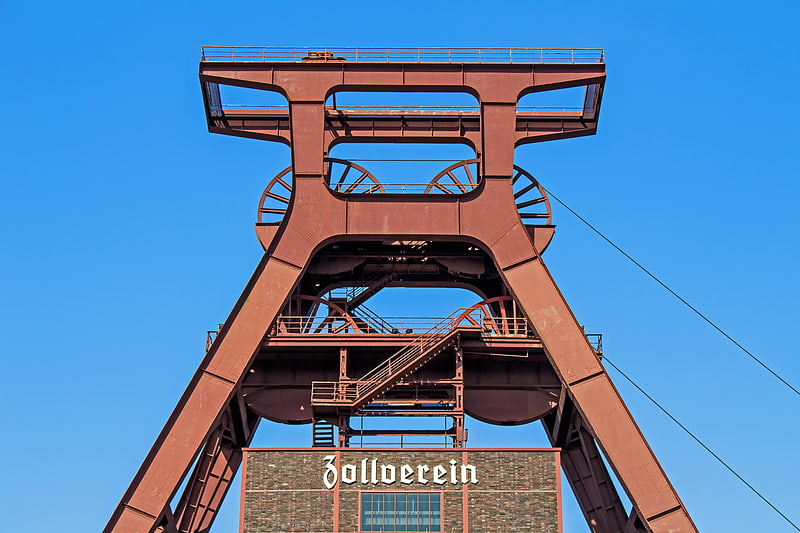
Also known as: Zeche Zollverein
Coal mining museum and monument. The Zollverein Coal Mine Industrial Complex is a large former industrial site in the city of Essen, North Rhine-Westphalia, Germany. It has been inscribed into the UNESCO list of World Heritage Sites since December 14, 2001, and is one of the anchor points of the European Route of Industrial Heritage.
The first coal mine on the premises was founded in 1847, and mining activities took place from 1851 until December 23, 1986. For decades, starting in the late 1950s, the two parts of the site, Zollverein Coal Mine and Zollverein Coking Plant (erected 1957−1961, closed on June 30, 1993), ranked among the largest of their kinds in Europe. Shaft 12, built in the New Objectivity style, was opened in 1932 and is considered an architectural and technical masterpiece, earning it a reputation as the "most beautiful coal mine in the world".[1]
Address: Gelsenkirchener Str. 181, 45309 Essen (Südoststadt)
Museum Folkwang
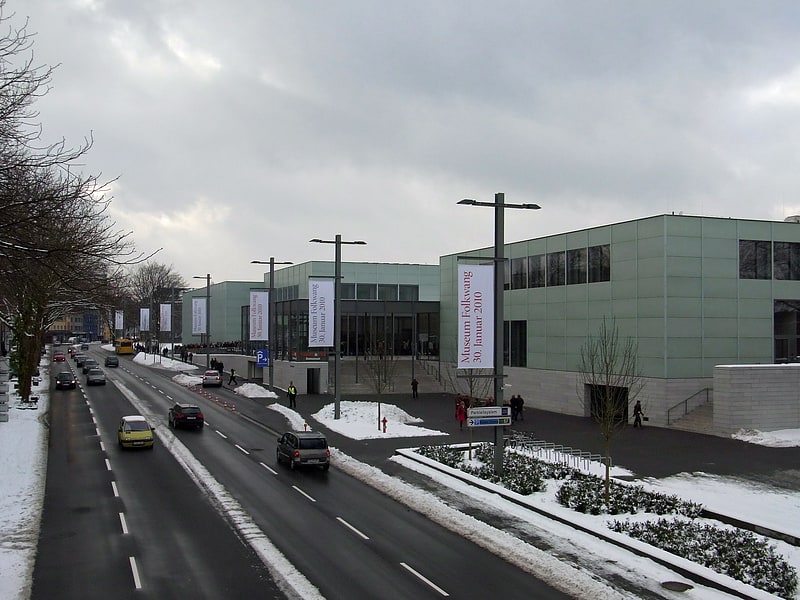
Museum in Essen, Germany. Museum Folkwang is a major collection of 19th- and 20th-century art in Essen, Germany. The museum was established in 1922 by merging the Essener Kunstmuseum, which was founded in 1906, and the private Folkwang Museum of the collector and patron Karl Ernst Osthaus in Hagen, founded in 1902.
The term Folkwang derives from the name of the afterlife meadow of the dead, Fólkvangr, presided over by the Norse goddess Freyja.
Museum Folkwang incorporates the Deutsche Plakat Museum (German poster museum), comprising circa 340,000 posters from politics, economy and culture. During a visit in Essen in 1932, Paul J. Sachs called the Folkwang "the most beautiful museum in the world."
In 2007, David Chipperfield designed an extension, which was then built onto the older building.[2]
Address: Museumsplatz 1, 45128 Essen (Stadtmitte - Frillendorf - Huttrop)
Villa Hügel
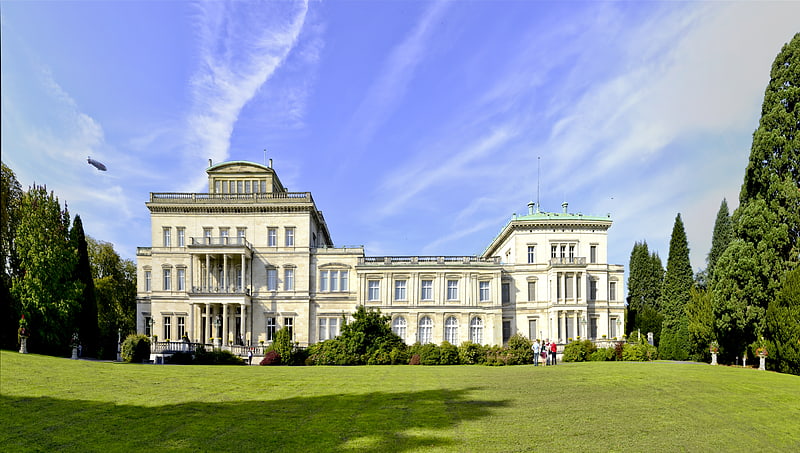
19th-century industrialist's manor house. The Villa Hügel is a 19th-century mansion in Bredeney, now part of Essen, Germany. It was built by the industrialist Alfred Krupp in 1870-1873 as his main residence and was the home of the Krupp family until after World War II. More recently, the Villa Hügel has housed the offices of the Kulturstiftung Ruhr, an art gallery, the historical archive of the Krupp family and company, and a concert venue.
Hügel simply means “hill”, as the villa sits atop a hill. It was sometimes named Villa Krupp, after the family.[3]
Address: Hügel 15, 45133 Essen (Werden - Kettwig - Bredeney)
Tetraeder
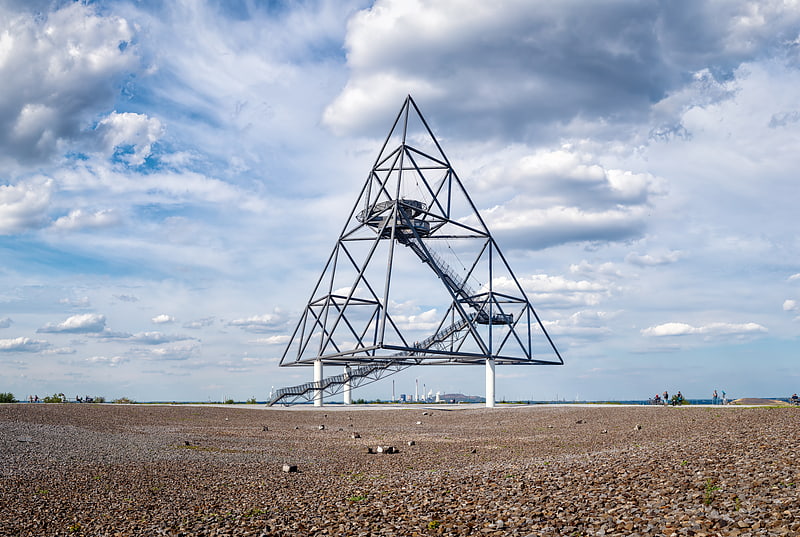
60-metre high tetrahedron sculpture. The Tetrahedron in Bottrop is a walkable steel structure in the form of a tetrahedron with a side length of 60m, resting on four 9m tall concrete pillars. It is located in Bottrop, Germany, on top of the mine dump Halde Beckstraße and serves as the town's landmark. It was opened on German Unity Day 3 October 1995.
The design is reminiscent of the Sierpinski tetrix: placing four half-size tetrahedra corner to corner and adding an octahedron in the middle, a full-size tetrahedron is formed; this process can be repeated recursively to form larger and larger tetrahedra.[4]
Address: 1 Beckstraße, Essen
Burgaltendorf
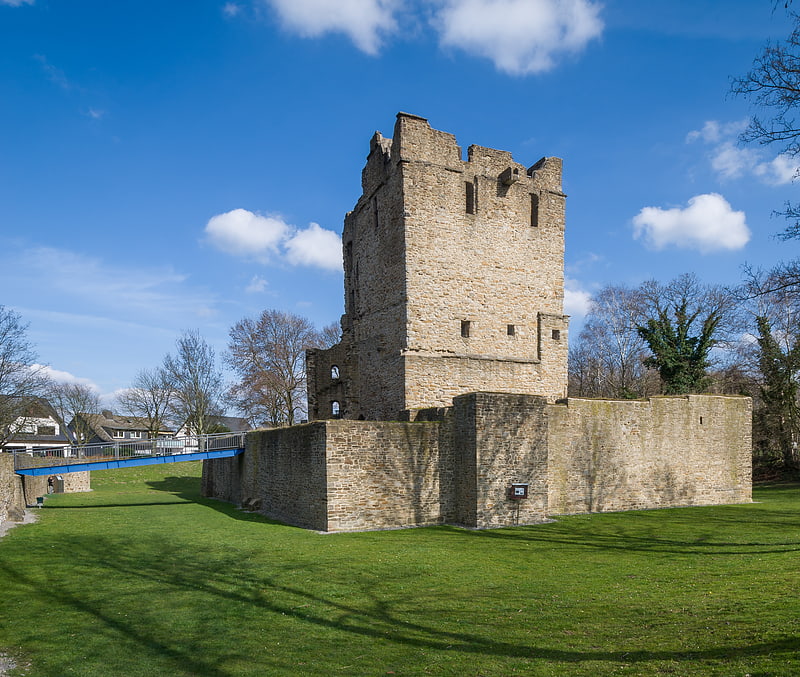
Burgaltendorf is a southeastern borough of the city of Essen in North Rhine-Westphalia in Germany. When the former independent municipality of Altendorf was incorporated into the city in 1970, it was renamed into Burgaltendorf to avoid confusion with the northwestern Essen borough of Altendorf. The borough Burgaltendorf is named after Castle Altendorf, which was built here in the 2nd half of the 12th century, probably between 1160 and 1180.[5]
Lichtburg

Lichtburg has been a popular name for cinemas in Germany. Those in Berlin, Essen and Düsseldorf have been particularly famous; the Lichtburg in Oberhausen is the site of the International Short Film Festival Oberhausen, and Quernheim is the smallest municipality in Germany with a cinema, also called Lichtburg.[6]
Address: Kettwiger Str. 36, 45127 Essen (Stadtmitte - Frillendorf - Huttrop)
Grugapark

Park and botanical garden with aviary. The Grugapark is a central park in the city of Essen, North Rhine-Westphalia, Germany. It was first opened in 1929 as the first "Große Ruhrländische Gartenbau-Ausstellung". Adjacent to the Grugapark is the Grugahalle concert hall and the Messe Essen exhibition centre.[7]
Address: Norbertstr. 2, 45147 Essen (Südstadt)
Essen Cathedral Treasury

Also known as: Essener Domschatz
Museum in Essen, Germany. The Essen Cathedral Treasury is one of the most significant collections of religious artworks in Germany. A great number of items of treasure are accessible to the public in the treasury chamber of Essen Minster. The cathedral chapter manages the treasury chamber, not as a museum as in some places, but as the place in which liturgical implements and objects are kept, which continued to be used to this day in the service of God, so far as their conservation requirements allow.[8]
Address: 2 Burgplatz, Essen (Stadtmitte - Frillendorf - Huttrop)
Alte Synagoge
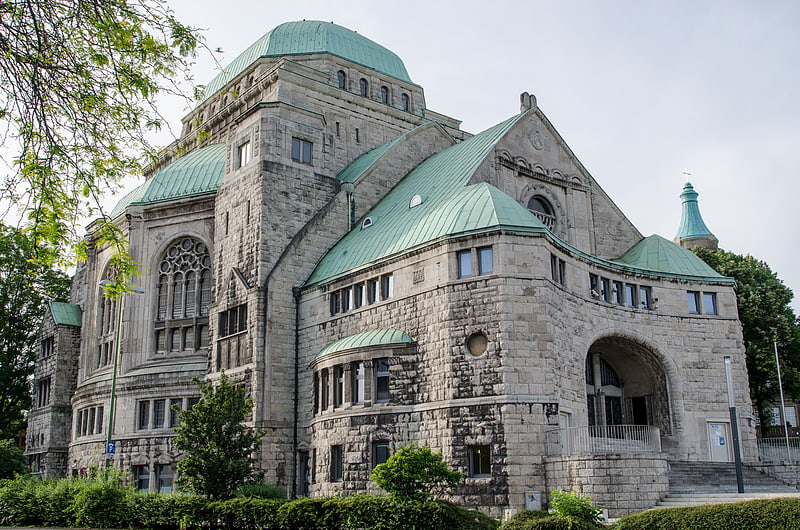
Cultural center exploring Jewish history. The Old Synagogue in Essen is one of the largest, best preserved and architecturally most impressive testimonies to Jewish culture in pre-war Germany. Built in the centre of the city, the Byzantine style former Synagogue was originally consecrated as the Neue Synagoge in 1913; it now houses an institution dedicated to documenting and promoting the history of the city's former Jewish community.
After being severely damaged during Kristallnacht in 1938, but fortunately avoiding further damage from bombing during WWII, the burnt out interior was first completely redesigned to become a Museum of Industrial design in 1960. With greater interest in historic preservation, it underwent a second restoration in the 1980s to its original design; in preparation for its new use as a memorial centre and museum. The attached Rabbinerhaus (House of the Rabbi) has housed the Salomon Ludwig Steinheim Institute since 2011.[9]
Address: Steeler Str. 29, 45127 Essen (Stadtmitte - Frillendorf - Huttrop)
Philharmonie Essen
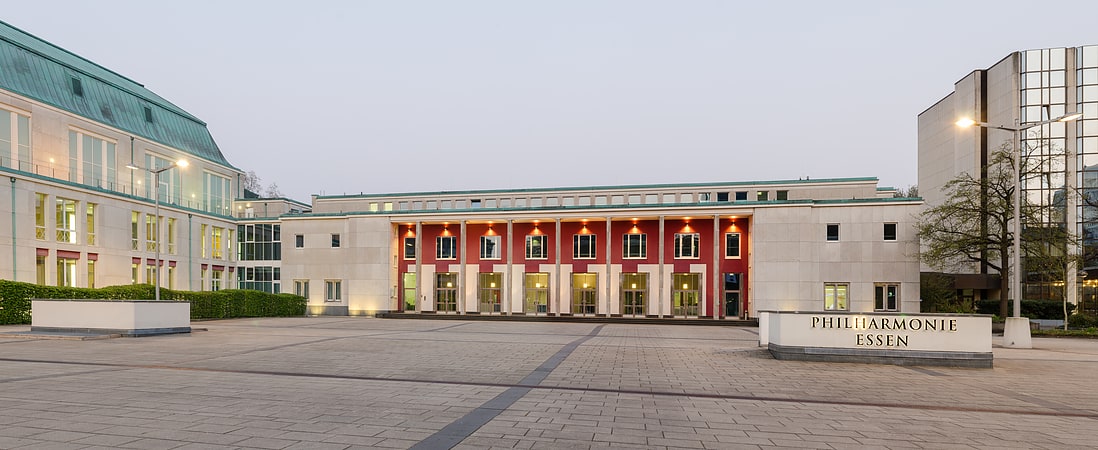
Also known as: Saalbau Essen
Concert hall in Essen, Germany. Saalbau Essen is a concert venue in Essen, Germany, the home of the Essen Philharmonic. The original building was completed in 1902, and destroyed during World War II on 26 July 1943. It was rebuilt between 1949 and 1954 and completely renovated in 2003 and 2004. The Saalbau Essen is located a little bit south of the city center close to the Aalto Theatre. Since the 2013/2014 season Tomáš Netopil has been the music director of Essener Philharmonic. Also since 2013/2014 Hein Mulders has been the intendant of the Saalbau Essen.[10]
Address: Huyssenallee 53, 45128 Essen (Stadtmitte - Frillendorf - Huttrop)
Aalto-Theater
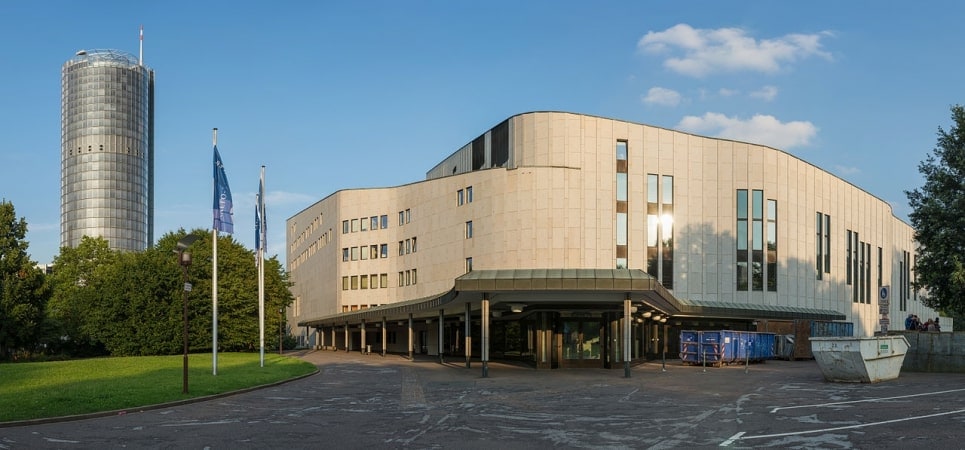
Performing arts center in Essen, Germany. The Aalto Theatre is a performing arts venue in Essen, Germany, and is home to the city's opera company Aalto-Musiktheater and the ballet company Aalto Ballett. The Essener Philharmoniker serve as the venue's orchestra. The theatre opened on 25 September 1988 with Richard Wagner's opera Die Meistersinger von Nürnberg and is mainly used for opera and ballet, but also for concerts and galas.
The design by the Finnish architect Alvar Aalto was the unanimous winner in a competition in 1959, but the building was begun only in 1983, seven years after Aalto's death. A feature of the auditorium's design is its asymmetrical layout and the indigo blue colour of the seats.
Conductor Wolf-Dieter Hauschild held the positions of both Intendant and Generalmusikdirektor in personal union from 1992 until 1997, followed by Stefan Soltesz from 1997 until 2013. Soltesz led the Essener Philharmoniker to the title Orchestra of the Year in 2003 and 2008 and the Aalto-Musiktheater to that of Opera House of the Year in 2008, following a survey of 50 critics by magazine Opernwelt.
He was succeeded as Intendant by Hein Mulders and as Generalmusikdirektor by Tomáš Netopil.[11]
Address: Opernplatz 10, 45128 Essen (Stadtmitte - Frillendorf - Huttrop)
Zeche Carl
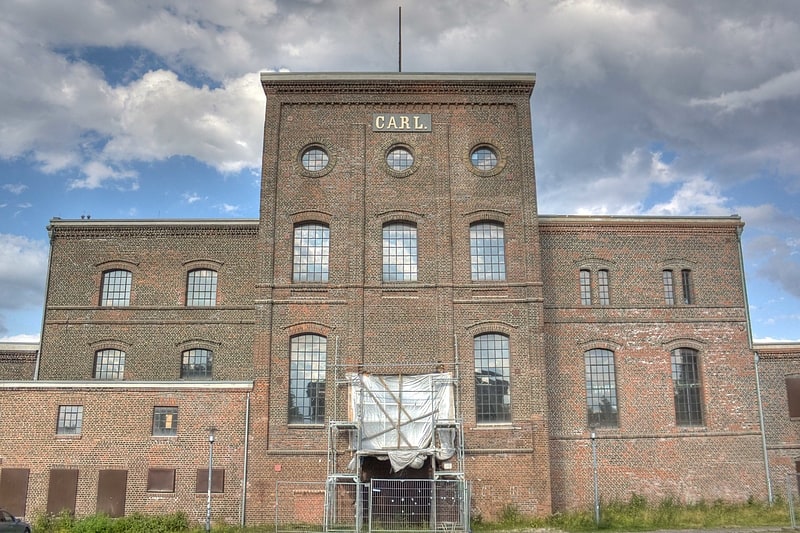
Cultural center in Essen, Germany. Zeche Carl is a cultural centre set up by Essen Council in a former coal mine.[12]
Address: Wilhelm-Nieswandt-Allee 100, 45326 Essen (Oststadt)
Colosseum Theater
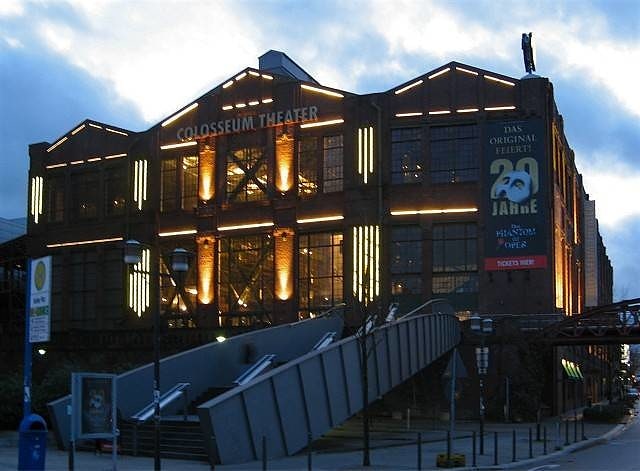
Theater in Essen, Germany. Colosseum Theater is a performance venue in Essen, Germany.[13]
Address: Altendorfer Str. 1, 45127 Essen (Stadtmitte - Frillendorf - Huttrop)
Byfang

Byfang is a southeastern borough of the city of Essen, Germany. It was incorporated into the city in 1929. Around 2,000 people live in Byfang, and it still has the character of a village. The name derives from befangen or umfangen, which means to surround, to enfold, because it has been a settlement surrounded by forest.[14]
Address: 69 Nöckersberg, Essen (Essen - Ruhrhalbinsel)
Essen City Hall
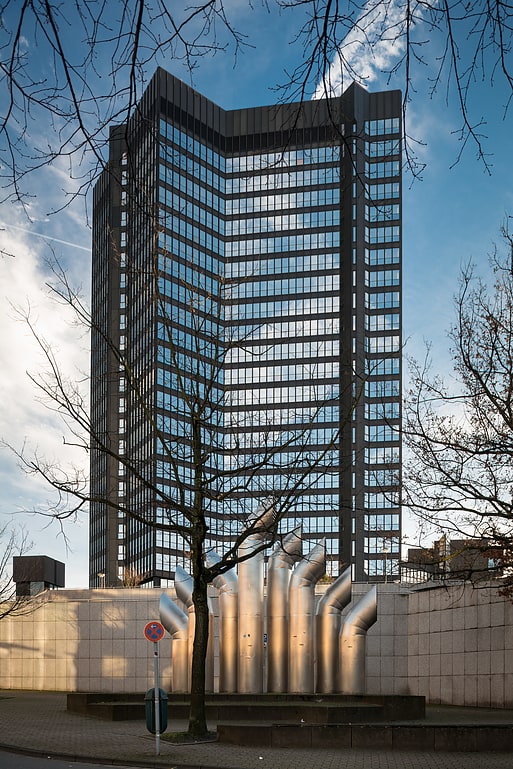
Also known as: Rathaus Essen
Skyscraper in Essen, Germany. Rathaus Essen is a 22-storey, 106 m skyscraper in Essen, Germany. When completed on 1 July 1979, it was the tallest city hall in Europe, and is currently the tallest city hall in Germany. It has a base floor area of more than 69,000 m2.[15]
Ruhr Museum

Museum in Essen, Germany. The Ruhr Museum, formerly the Ruhrland Museum, is a diverse natural history and cultural history museum for the Ruhrgebiet in Essen, Germany. The sponsor is the Stiftung Ruhr Museum. Director since 2012 is the historian Heinrich Theodor Grütter.[16]
Address: Gelsenkirchener Str. 181, 45309 Essen/Ruhr (Südoststadt)
St. Johann Baptist

Catholic church in Essen, Germany. The Catholic parish church of St. Johann Baptist is a Gothic hall church in Essen, dedicated to John the Baptist, which stands on Kettwiger Straße, the main street of Essen, in front of Essen Minster, to which it is connected. On account of its position and the fact that its spire towers over the Minster, visitors often mistake it for part of the Minster.[17]
Address: An St. Quintin, 45127, Essen, Essen (Stadtmitte - Frillendorf - Huttrop)
Stratmanns Theater
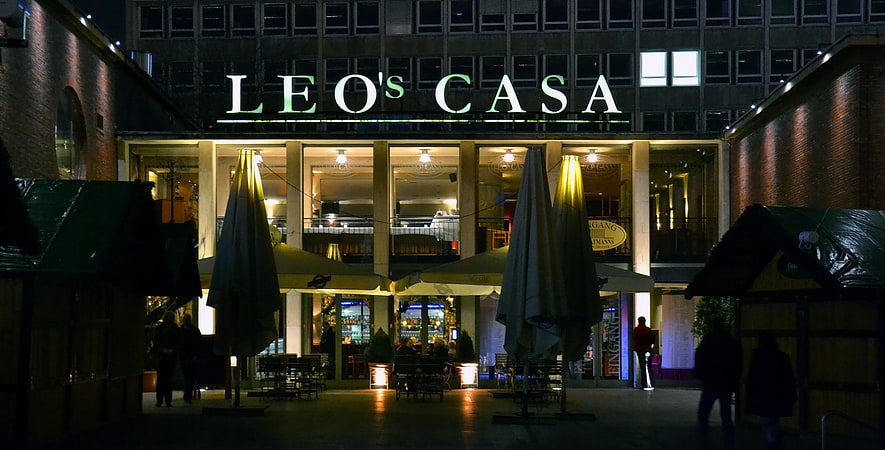
Theatre in Essen, Germany. Stratmanns Theater Europahaus is a theatre in Essen, North Rhine-Westphalia, Germany.[18]
Address: Kennedyplatz 7, 45127 Essen (Stadtmitte - Frillendorf - Huttrop)
Bredeney
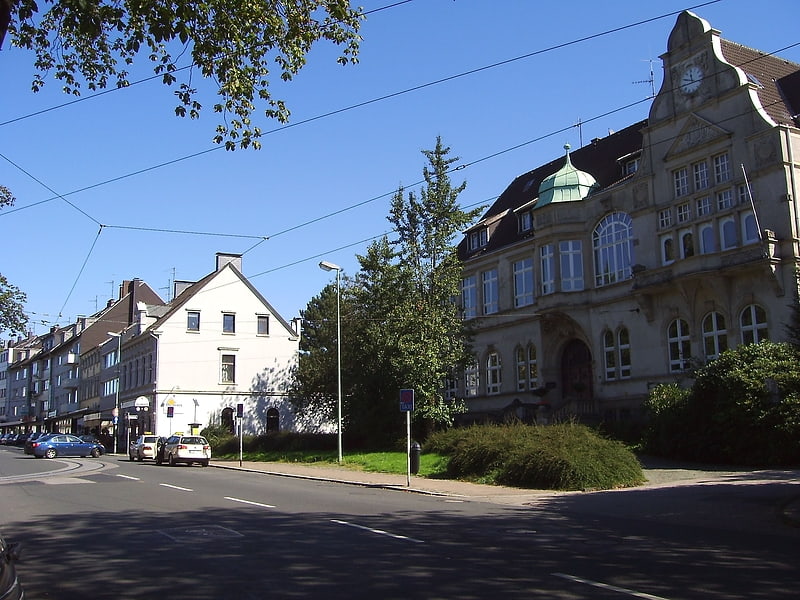
Bredeney is a southern borough of the city of Essen, Germany. It was incorporated into the city in 1915. Around 10,700 people live here. Bredeney is known to be a wealthy borough and the "green lung" of the city.
Lake Baldeney and the Villa Hügel, heritage of the Krupp family are located here, as well as Essen-Hügel station.[19]
Grillo-Theater
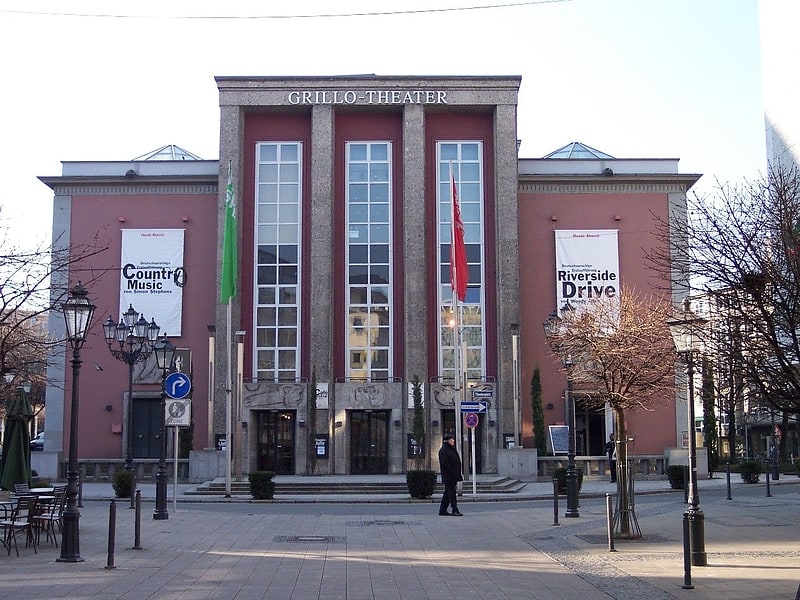
Theatre in Essen, Germany. Grillo-Theater is a theatre in Essen, Germany. Named after the industrialist Friedrich Grillo, who made the building possible, it opened on 16 September 1892 with Lessing's drama Minna von Barnhelm.
The building was badly damaged in World War II; it was restored with a much simpler façade and re-opened in 1950 with Wagner's opera Die Meistersinger von Nürnberg. Notable directors included Erwin Piscator, Jean-Louis Barrault, Heinz Dietrich Kenter, Hansgünther Heyme. Caspar Neher became head of design in 1927 and designed here eight operas and 11 plays.
In 1988, the role of the Grillo-Theater as Essen's major stage venue was taken by the newly constructed Aalto Theatre which also opened with Die Meistersinger. Following a major reconstruction by the architect Werner Ruhnau and a reduction of the auditorium from 670 to 400 seats, the Grillo-Theater became a flexible smaller venue; it re-opened in September 1990 with Shakespeare's A Midsummer Night's Dream.[20]
Address: Theaterpl. 11, 45127 Essen (Stadtmitte - Frillendorf - Huttrop)
Das Kleine Theater Essen

Theatre in Essen, Germany. Das Kleine Theater Essen is a theatre in Essen, North Rhine-Westphalia, Germany.[21]
Address: Gänsemarkt 42, Essen (Stadtmitte - Frillendorf - Huttrop)
GOP Varieté Essen
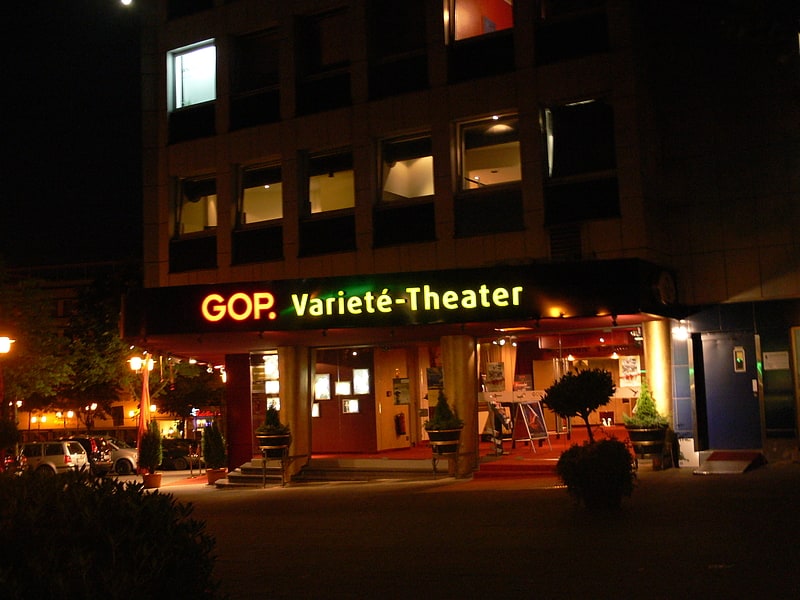
Theatre in Essen, Germany. GOP Varieté Essen is a theatre in Essen, North Rhine-Westphalia, Germany.[22]
Address: Rottstraße 30, 45127 Essen (Stadtmitte - Frillendorf - Huttrop)
Kunsthaus Essen
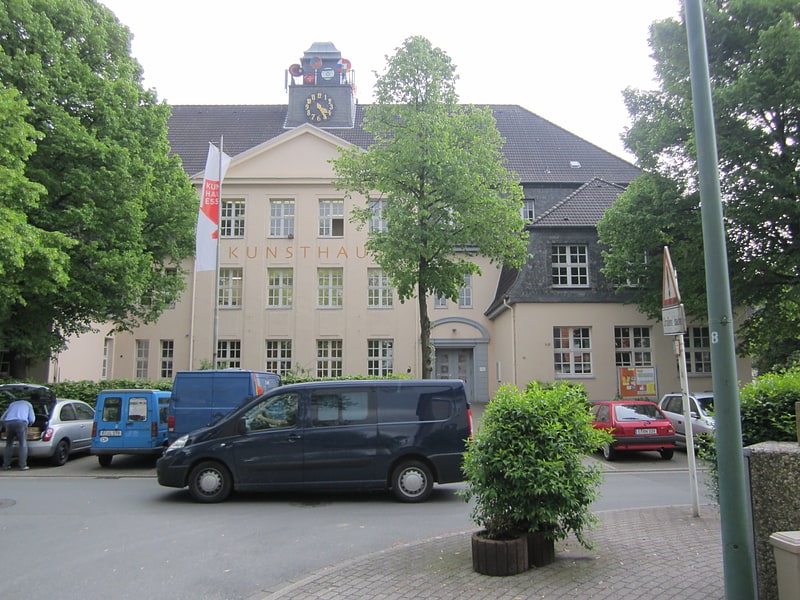
Kunsthaus Essen in the Rellinghausen district of Essen is an exhibition and event center for artists in Essen.
Address: Rübezahlstraße 33, 45134 Essen (Südstadt)
Golden Madonna of Essen
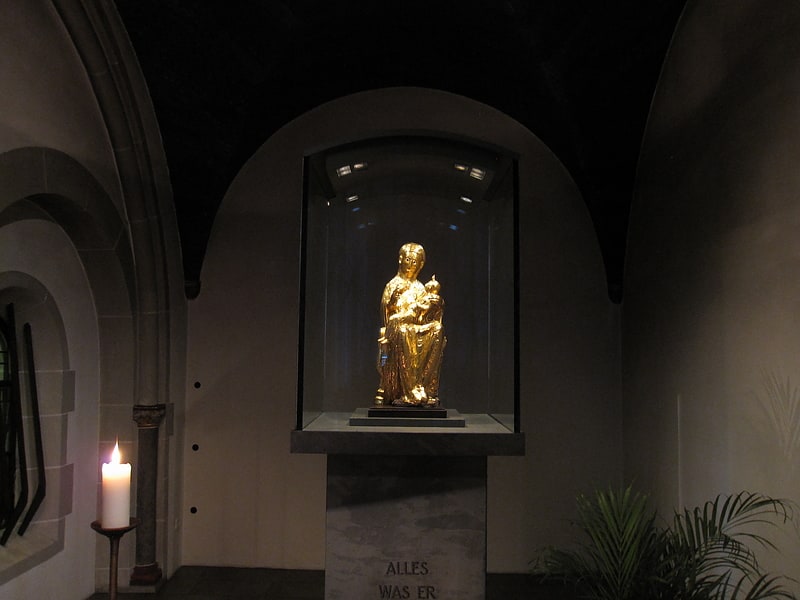
Also known as: Goldene Madonna
The Golden Madonna of Essen is a sculpture of the Virgin Mary and the infant Jesus. It is a wooden core covered with sheets of thin gold leaf. The piece is part of the treasury of Essen Cathedral, formerly the church of Essen Abbey, in North Rhine-Westphalia, Germany, and is kept on display at the cathedral.
Dated around the year 980, it is both the oldest known sculpture of the Madonna and the oldest free-standing medieval sculpture north of the Alps, and is also one of the few major works of art to survive from Ottonian times. To this day it remains an object of veneration and symbol of identity for the population of the Ruhr Area. It is the only full-length survival from what appears to have been a common form of statue among the wealthiest churches and abbeys of 10th and 11th century Northern Europe; some of these were life-size, especially figures of the Crucifixion.[23]
Essen Minster
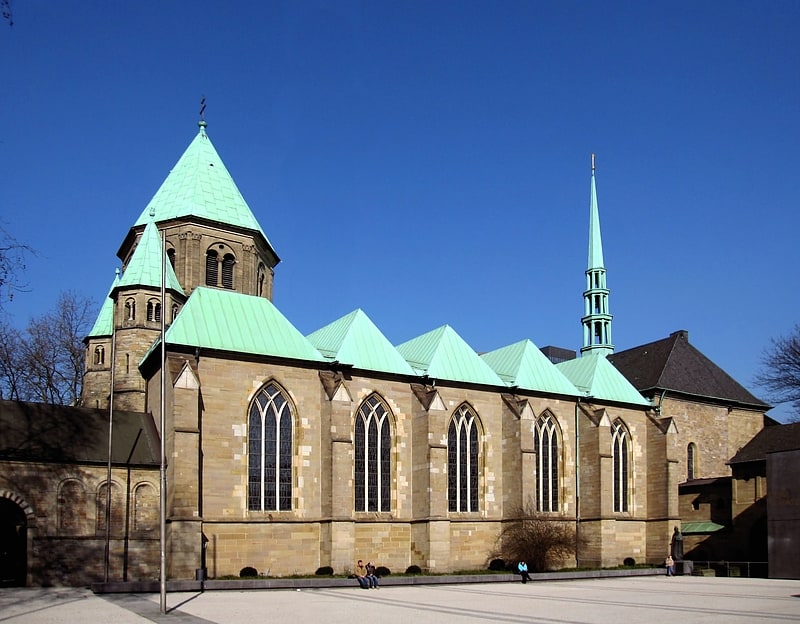
Also known as: Essener Münster
Building in Essen, Germany. Essen Minster, since 1958 also Essen Cathedral is the seat of the Roman Catholic Bishop of Essen, the "Diocese of the Ruhr", founded in 1958. The church, dedicated to Saints Cosmas and Damian and the Blessed Virgin Mary, stands on the Burgplatz in the centre of the city of Essen, Germany.
The minster was formerly the collegiate church of Essen Abbey, founded in about 845 by Altfrid, Bishop of Hildesheim, around which the city of Essen grew up. The present building, which was reconstructed after its destruction in World War II, is a Gothic hall church, built after 1275 in light-coloured sandstone. The octagonal westwork and the crypt are survivors of the Ottonian pre-Romanesque building that once stood here. The separate Church of St. Johann Baptist stands at the west end of the minster, connected to the westwork by a short atrium – it was formerly the parish church of the abbey's subjects. To the north of the minster is a cloister that once served the abbey.
Essen Minster is noted for its treasury (Domschatz), which among other treasures contains the Golden Madonna, the oldest fully sculptural figure of Mary north of the Alps.[24]
Address: 14th century cathedral and treasure museum, Essen (Stadtmitte - Frillendorf - Huttrop)
Botanical Garden
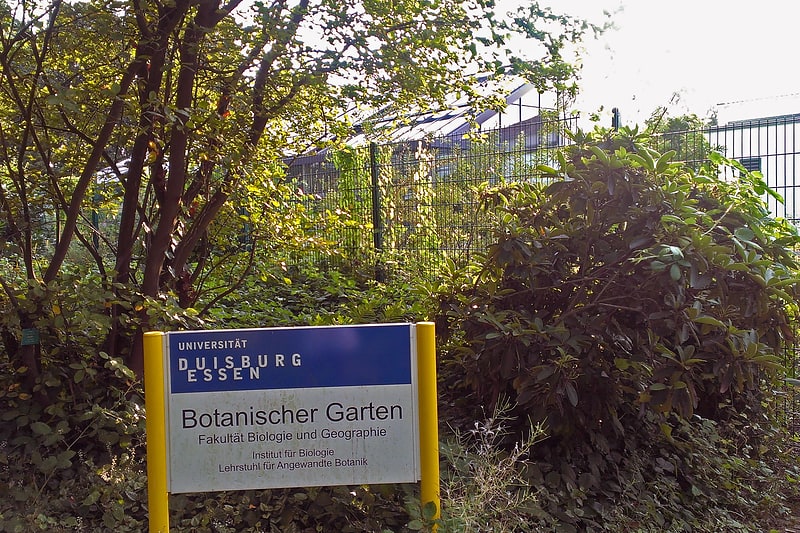
Also known as: Botanischer Garten
The Botanischer Garten der Universität Duisburg-Essen (4,100 square metres is a botanical garden maintained on the Essen campus of the University of Duisburg-Essen, North Rhine-Westphalia, Germany. It formerly was located at Henri-Dunant-Strasse 65. Now it is located next to the Grugapark area at Kühlshammerweg 30. The garden is maintained for research and educational uses, and is not open to the public.
The garden was established in the early 1980s by Dr. Guido Benno Feige, Professor of Botany. Today, it cultivates approximately 3,500 species in an outdoor area (3,000 square metres (32,000 sq ft)) and greenhouses (1,100 square metres (12,000 sq ft)). The garden contains about 170 species of carnivorous plants, one of the largest such collections in Germany, as well as good collections of Euphorbia (300 species), Mediterranean plants (250 species), Haworthia and Aloe (65 species), as well as Aeonium, Conophyllum (40 species), Rhipsalis, and rare plants from Socotra.[25]
RWE Tower
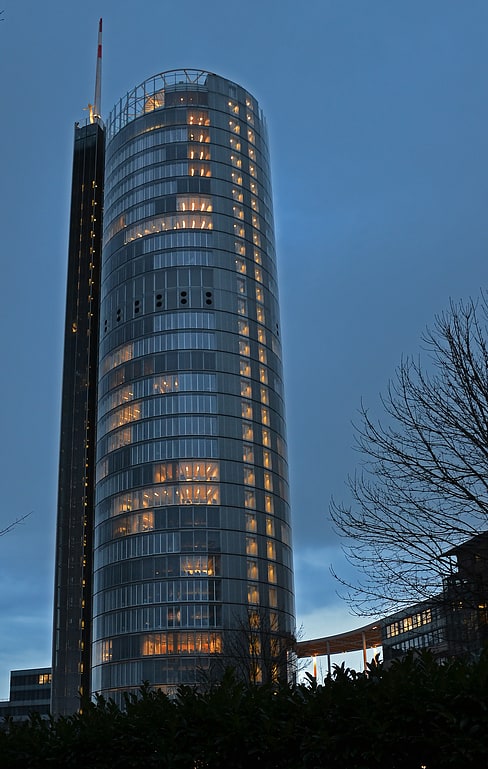
Also known as: RWE-Turm
Skyscraper in Essen, Germany. The RWE Tower in Essen is the highest building in the Ruhr area, and one of the highest buildings in Germany. It is used by RWE AG. As it shows the cultural and industrial change of the region, it is an important landmark in Essen. The skyscraper was designed by Ingenhoven Architects.[26]
Address: Opernplatz 1, 45128 Essen (Stadtmitte - Frillendorf - Huttrop)
Haus der Technik
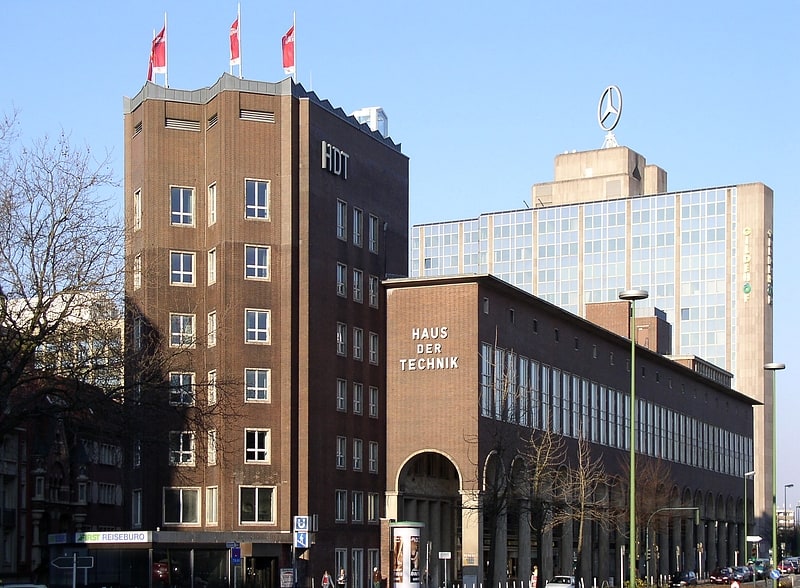
Haus der Technik, or HDT for short, is Germany's oldest independent technical training institute, with headquarters in Essen and branches in Berlin and Munich.
The Essen headquarters, designed by Edmund Körner, inaugurated in 1930 and listed since 1987, is located north of Essen's main train station and served the former Essen Stock Exchange until 1934.
Address: Hollestr. 1, Essen (Stadtmitte - Frillendorf - Huttrop)
Kennedyplatz
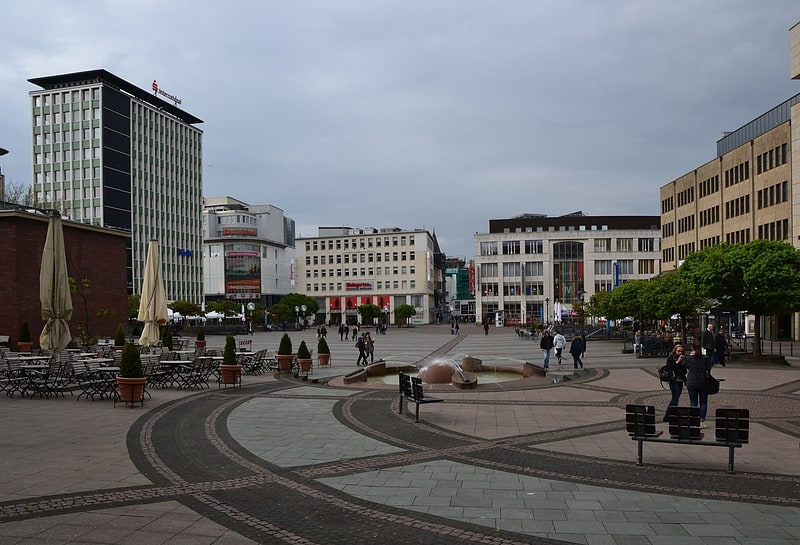
Tourist attraction in Essen, Germany. Kennedyplatz is a plaza in the German city of Essen. It was laid out on a previously densely-built site which had been destroyed in the Second World War. Today, the area serves as an inner-city event space.
Previously known as the Gildenplatz, the square was renamed on 17 December 1963 in memory of US president John F. Kennedy, who was assassinated the previous month.[27]
Essen-Borbeck-Mitte
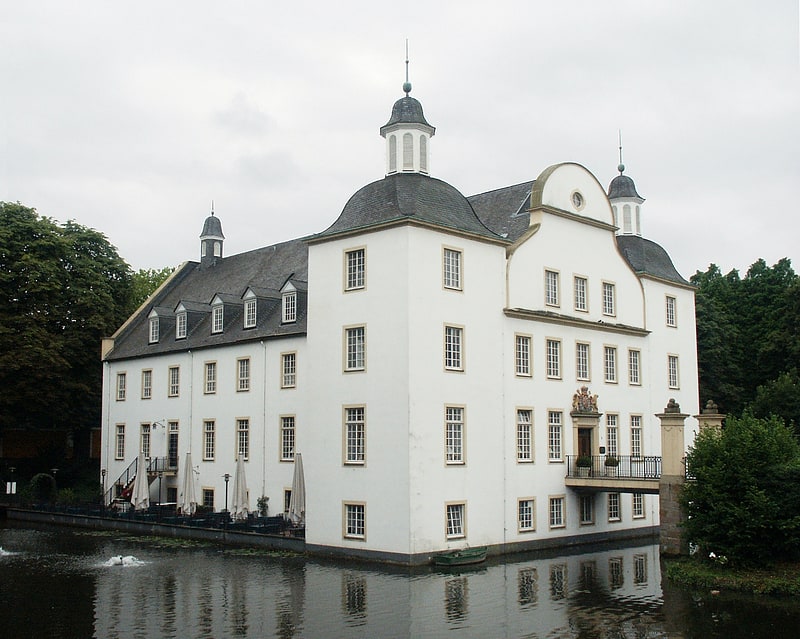
Also known as: Borbeck-Mitte
Borbeck-Mitte is the central borough of Borbeck, the fourth suburban district of Essen, Germany. Together with the other boroughs of the district, it was incorporated on April 1, 1915. Borbeck-Mitte has a population of roughly 13,500 people and a total area of 3.19 km2 or 1.23 sq mi. The name Borbeck derives from Borthbeki, which means either river in a fertile lowland or river of the Bructeri.[28]
Address: Hülsmannstraße 6, Essen (Borbeck)
Red Dot Design Museum
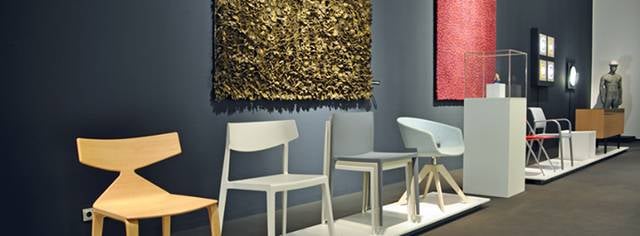
Museum, Specialty museum, Art museum
Address: Gelsenkirchener Str. 181, 45309 Essen (Südoststadt)
Folkwang University of the Arts
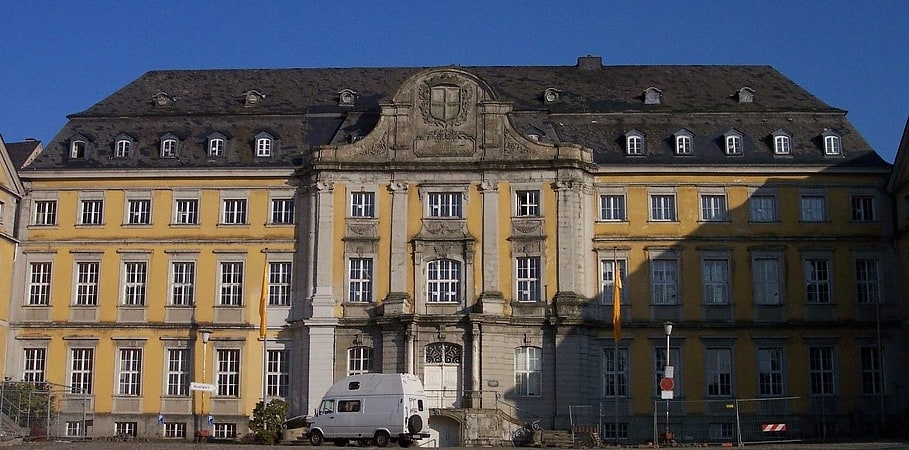
Also known as: Folkwang Universität der Künste
University in Essen, Germany. The Folkwang University of the Arts is a university for music, theater, dance, design, and academic studies, located in four German cities of North Rhine-Westphalia. Since 1927, its traditional main location has been in the former Werden Abbey in Essen in the Ruhr area, with additional facilities in Duisburg, Bochum, and Dortmund, and, since 2010, at the Zeche Zollverein, a World Heritage Site also in Essen. The Folkwang University is home to the international dance company Folkwang Tanz Studio. Founded as Folkwangschule, its name was Folkwang Hochschule from 1963 until 2009.[29]
Address: Klemensborn 39, 45239 Essen (Werden - Kettwig - Bredeney)
Tiegelstahlgussdenkmal
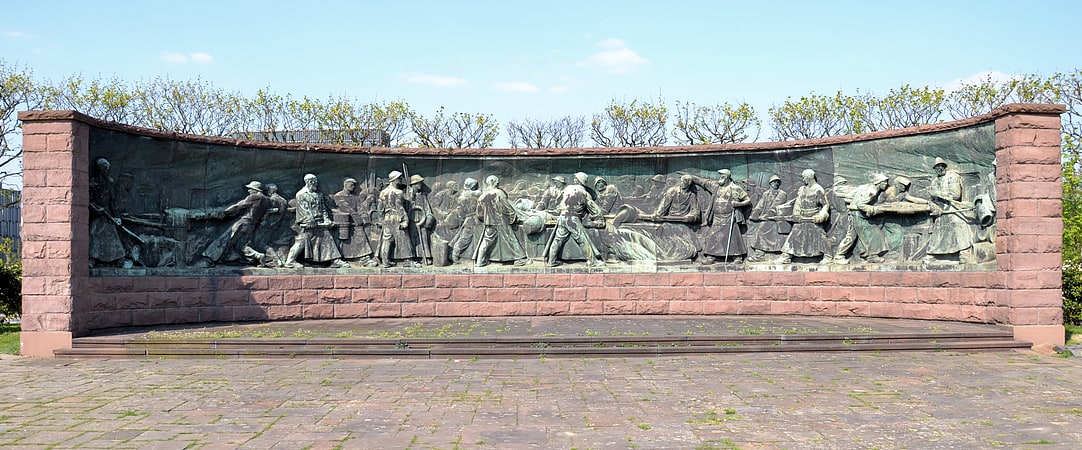
Memorial
Address: 104 Altendorfer Straße, Essen (Stadtmitte - Frillendorf - Huttrop)
Schurenbachhalde
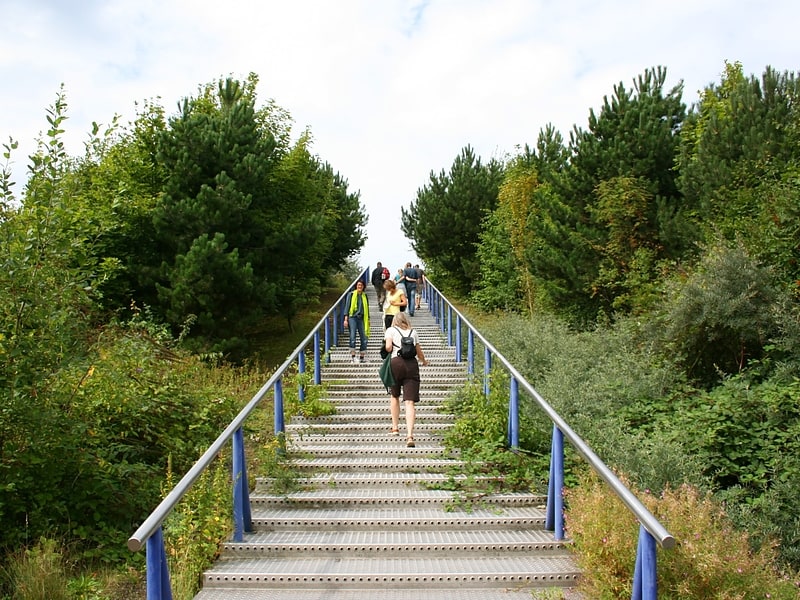
The Schurenbachhalde is an approximately 50-meter-high tailings pile of the coal mining industry in the Altenessen district of Essen. The tailings pile is named after the water body "Schurenbach", which was buried under it from the 1970s onwards, and is located directly on the Rhine-Herne Canal, between Emscherstraße and Nordsternstraße and near the Nordsternpark Gelsenkirchen.
The tailings pile was used by the Zollverein colliery to store overburden until its closure in 1986. Until the mid-1990s, other coal mines also unloaded their overburden on this tailings pile. Subsequently, the tailings pile was renaturalized and converted into a landscape monument.
The 15-meter-high sculpture Bramme für das Ruhrgebiet (Slab for the Ruhr) by American artist Richard Serra, erected in 1998, is a landmark on the top of the slag heap.
The Schurenbachhalde is part of the Route of Industrial Heritage and is to become part of the International Garden Exhibition 2027.
Stadtgarten Essen

The Stadtgarten Essen is Essen's oldest publicly accessible green space. It is located south of Essen's main train station in the Südviertel district, between the Aalto Theater, the Philharmonie and the adjacent Rüttenscheid district.
The beginnings of the park date back to 1859. In 1877, the Bürgerpark became the first public park in Essen to be transferred to municipal ownership. Since 1881 it has borne the name Stadtgarten.